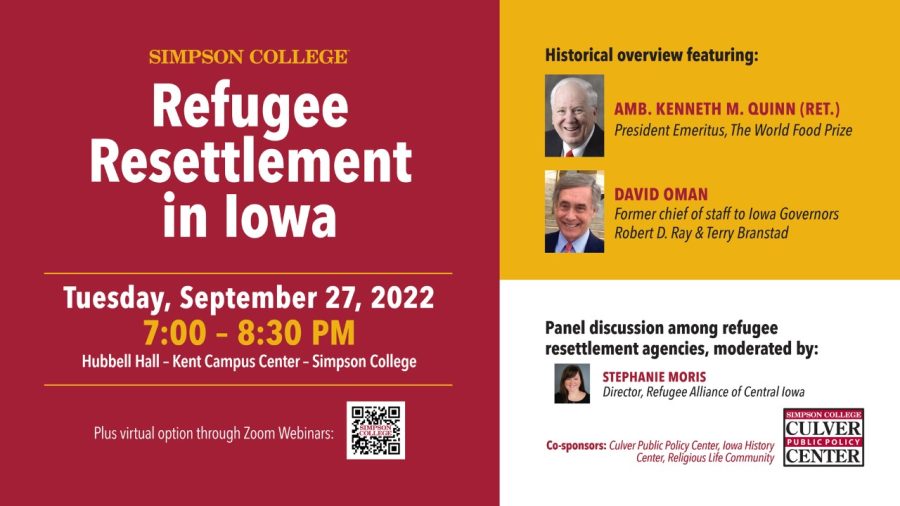Simpson College remembers Iowa’s history of refugee resettlement
October 5, 2022
The Culver Center hosted a discussion with two influential leaders on the resettlement efforts and policy of the late 1970s last Tuesday.
The two panelists were David Oman, the governor’s chief of staff at that time, and Kenneth Quinn, a diplomat on loan from the state department at that time. A crowd of 30 people came to hear them speak.
The focus of the discussion was the late Iowan governor, Robert Ray and his work after the Vietnam war to resettle thousands of refugees from Southeast Asia.
“There were no mechanisms in place to deal with this sudden flood of refugees who came to the United States,” Quinn said. This left the federal government scrambling to relocate all the migrants.
Eventually, the department of health, education and wellness—now known as the department of health and human services—began dispersing migrants throughout the states.
“It wasn’t a deal where states could choose,” Quinn said. “The federal government apportioned refugees.”
With 130,000 refugees to settle, the state governments had their work cut out for them.
Iowa’s governor at the time was Robert Ray, who’d recently been elected to a fourth term. Ray rose to the challenge and, with the help of Oman and Quinn, created a strategy not only to take in, but to integrate the refugees.
“The people of Iowa trusted him,” Oman said. “So we invited the press to come in, or we saw them in their offices.”
The public relations strategy kept the process smooth and encouraged acceptance of the migrant population.
Ray’s other mission in the resettlement efforts was to keep the migrant communities together.
“Among those were a group from Laos called the Tai Dam,” Quinn said. “They are several thousand, and they’re about to be scattered across the United States.” Ray didn’t want to see the ethnic group broken up, so he offered that Iowa would take in all the Tai Dam.
Ray succeeded and, using the public relations strategy developed in the early days, was able to integrate the Tai Dam fully.
Four years after the initial surge, a second wave of migrants began fleeing South East Asia in boats. These migrants would sail from the coast of Vietnam and hope to reach land somewhere else.
But even when they survived the journey to another country, they would often be turned away. The international community, it seemed, would settle no more refugees.
Governor Ray, however, wasn’t done with his work.
“He drafted a letter to the president,” Quinn said. “Pledging that Iowa will resettle the refugees, if you’ll just open the doors.”
This made Ray the first governing person in the world to promise to resettle these refugees.
Ray’s commitment to this even crossed party lines. President Carter was a Democrat, but Ray didn’t care. He even attended a conference of the UN with a delegation, including Vice President Walter Mondale, also a Democrat.
Because of his persistence, the Carter administration began sending the U.S. Navy to collect the migrants with the goal of resettling 160,000 of them.
Ultimately, Robert Ray succeeded in his mission of fulfilling what he saw as America’s duty to take care of the Southeast Asian refugees displaced during the war.
“‘We can either turn our backs, or we can extend our hand,’ Ray thought,” said Quinn. “He made it happen.”
The panel took place the day after what would have been Governor Ray’s 94th birthday, adding to the respect the panel showed for his life and legacy in Iowa and in America.







